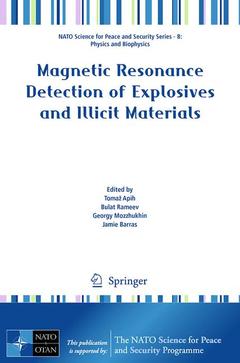Description
Magnetic Resonance Detection of Explosives and Illicit Materials, 2014
NATO Science for Peace and Security Series B: Physics and Biophysics Series
Coordinators: Apih Tomaž, Rameev Bulat, Mozzhukhin Georgy, Barras Jamie
Language: English
Publication date: 10-2013
168 p. · 15.5x23.5 cm · Paperback
Publication date: 10-2013
168 p. · 15.5x23.5 cm · Hardback
Description
/li>Contents
/li>Comment
/li>
Detection of concealed explosives is a notoriously difficult problem, and many different approaches have been proposed to solve this problem. Nuclear quadrupole resonance (NQR) is unique in many ways. It operates in a safe AM radio frequency range, and it can remotely detect unique ?fingerprint? (NQR spectrum) of many explosives, such as TNT or RDX. As such, the detection of target does not depend on the shape or material of the container, or the presence of metallic object such as triggers etc. Spectra of chemically similar compounds differ enough that their presence never causes interference or false alarms. Unfortunately, widespread use is prevented due to low sensitivity, radiofrequency interference from the noisy environment, and inability to detect liquid explosives. This book presents current state of the art of the attempts to overcome NQR sensitivity problem, either by increasing the strengths of signals generated, or by increasing the specificity of the technique through a better understanding of the factors that affect the quadrupolar parameters of specific explosives. The use of these specific quadrupolar parameters is demonstrated on signal processing techniques that can detect weak signals, which are hidden in a noisy background. The problem of differentiation of liquid explosives and benign liquids in closed containers is approached by measurements of different nuclear magnetic resonance (NMR) parameters. As shown, a couple of solutions has reached a prototype stage and could find their use in a near future.
Part 1 Nuclear Quadrupole Resonance Detection of Solids.- Further improvement of NQR technique for detection of illicit substances; T. N. Rudakov.- An Overview of NQR Signal Detection Algorithms; N. R. Butt et al.- Nuclear Quadrupole Resonance of Pantaerythritol Tetranitrate (PETN) in Different Compositions; M.D. Rowe et al.- Cross-relaxation enhanced NQR of ammonium nitrate in low magnetic field; G.V. Mozzhukhin et al.- Investigating homonuclear broadening in NQR with Carr-Purcell Meiboom-Gill performed on p-chloroaniline; M.W. Malone, K. L. Sauer.- Size Effect in 14N Nuclear Quadrupole Resonance Spectroscopy; N. Sinyavsky.- NQR Detection of Sodium Nitrite Recrystallized in Wood; J. Jover et al.- Part 2 Nuclear Magnetic Resonance Detection of Liquids.- Bottled Liquid Scanner for Security Checkpoints; Pablo J. Prado.- MagViz: A Bottled Liquids Scanner Using Ultra-low field NMR Relaxometry; R. Austin et al.-Multiparameter NMR Identification of Liquid Substances; A. B. Konov et al.- NMR-Based Liquid Explosives Detector: Advantages and Disadvantages of Different Configurations; A. Gradišek et al.-Composite Pulses in Inhomogeneous Field NMR; G.S. Kupriyanova et al.- Part 3 Other Techniques.-Novel HTS DC Squid Solutions For NMR Applications; M.L. Chukharkin et al.- Passive Sub THz Imaging; A. Vertiy, A. Pavlyuchenko.
Covers both detection of solid explosives by NQR and liquid explosives by NMR
Comprehensive review of recent progress and opened problems
Progress in 14N nuclear quadrupole resonance techniques
These books may interest you

Structural Phase Transitions II 52.74 €



